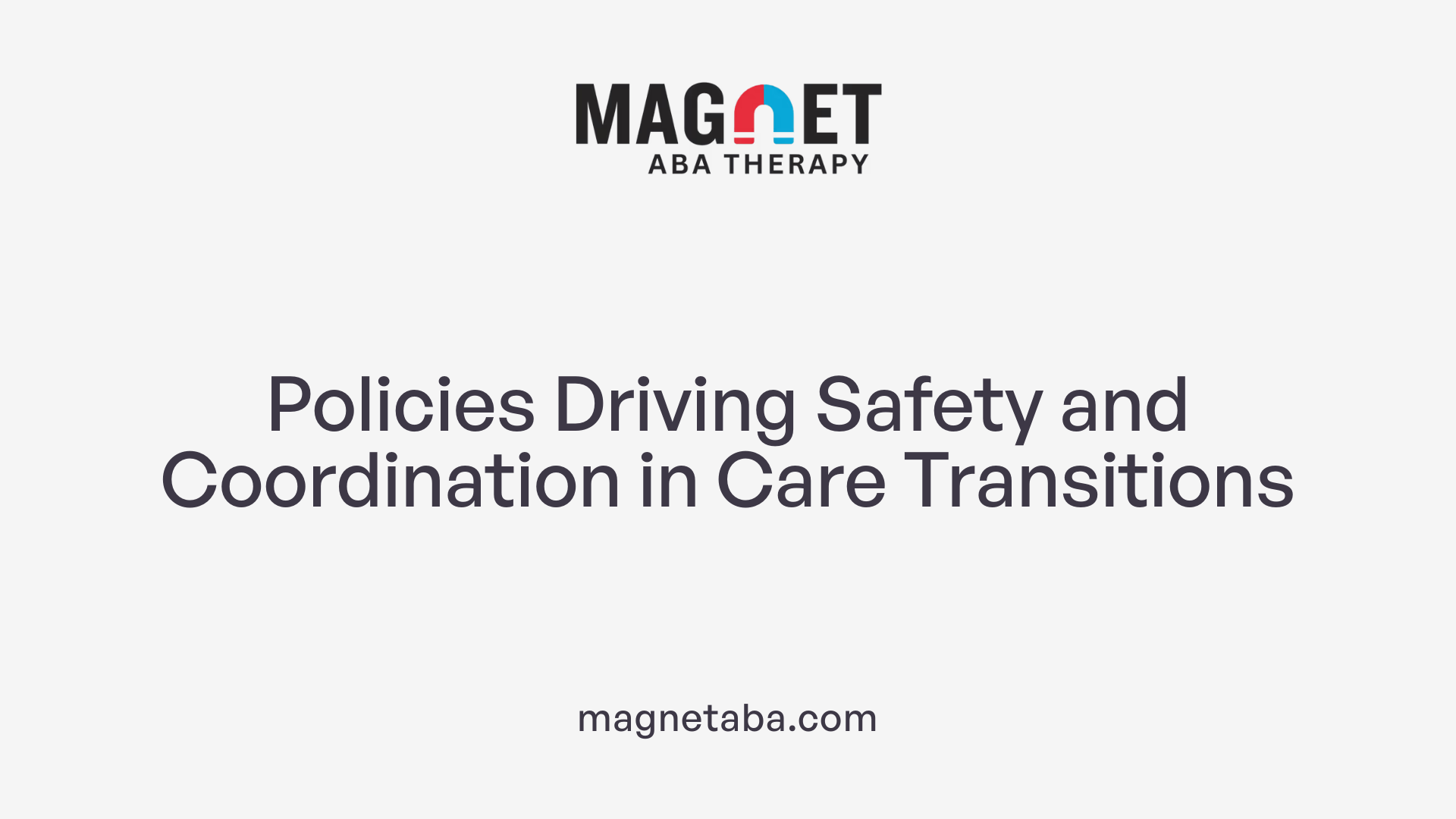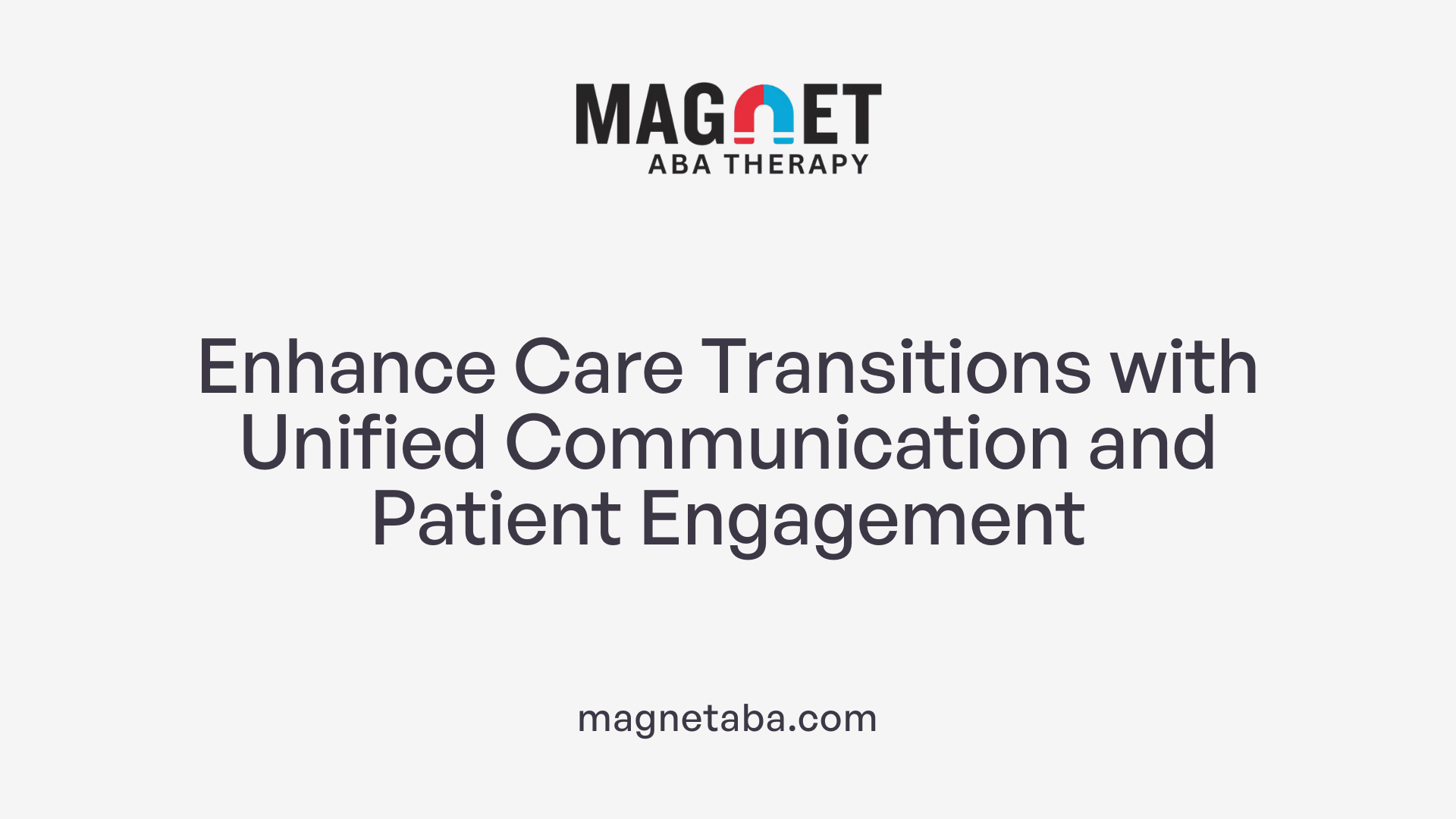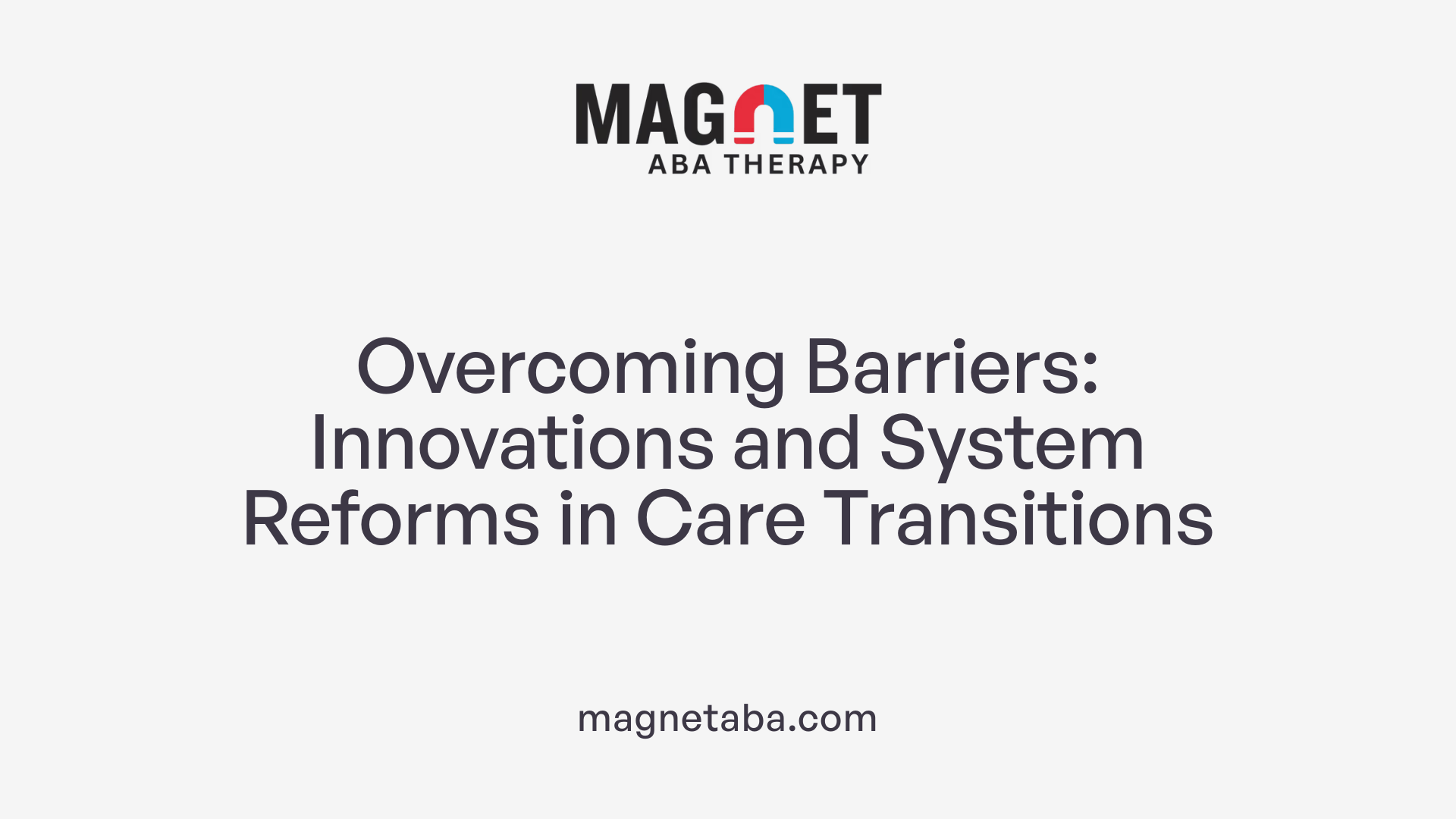Understanding the Importance of Effective Transitions in Healthcare and Social Services
Transitions across healthcare settings and between different populations are critical junctures that can significantly influence patient outcomes, safety, and overall quality of care. With the complexity of modern healthcare systems, supporting these transitions requires comprehensive, evidence-based frameworks, organizational policies, and a coordinated approach involving multidisciplinary teams, patients, and caregivers. This article explores best practices, models, organizational strategies, and tailored approaches necessary to facilitate safe, smooth, and effective care transitions across diverse settings and populations.
Key Frameworks and Evidence-Based Models for Transitional Care

What are some evidence-based frameworks or models for transitional care?
Efficient and safe transitions in healthcare are crucial for maintaining patient health and preventing rehospitalizations. Several well-established models and frameworks have been developed and validated through research to support healthcare providers, patients, and caregivers in managing these transitions effectively.
One of the most prominent models is the Transitional Care Model (TCM). This nurse-led intervention has been supported by numerous randomized control trials demonstrating significant reductions in hospital readmissions, improved quality of life, and cost savings. The TCM emphasizes comprehensive assessment, patient education, medication management, and seamless coordination between hospital and community providers. Core components include screening at-risk patients, providing tailored education about health conditions, and establishing follow-up routines to ensure ongoing support.
Another key framework is the Care Transitions Intervention (CTI). This brief, targeted program employs a transition coach to teach patients self-management skills, communication techniques, and medication routines. Its primary goal is to empower patients to recognize symptoms of deterioration, adhere to treatment plans, and effectively communicate with healthcare providers after discharge. Studies have shown that CTI significantly reduces hospital readmissions at 30, 60, and 180 days, while also controlling healthcare costs.
Supporting these models is the Four Pillars Framework, which rests on four interconnected elements that collectively enhance patient safety during transitions:
| Pillar | Focus | Examples | Impact |
|---|---|---|---|
| Medication management | Ensuring safe medication use | Medication reconciliation, patient education, adherence checks | Reduces medication errors and adverse drug events |
| Personal health records | Maintaining accurate health information | Shared digital records, patient-held summaries | Facilitates continuity and clarity |
| Follow-up care | Timely post-discharge contacts | Scheduled outpatient visits, home visits, telehealth | Decreases readmission risk |
| Red flag knowledge | Recognizing warning symptoms | Patient education on symptoms needing urgent attention | Prevents deterioration and emergency interventions |
These core models and frameworks are often supported through collaborative efforts involving organizations like the Aging and Disability Resource Centers, which foster community-based, patient-centered care planning. They emphasize timely communication, standardized transfer protocols, and the integration of electronic medical records to improve information transfer.
Tools such as structured discharge checklists, electronic health record systems, and standardized transfer forms play vital roles in reducing errors, ensuring clarity, and maintaining continuity across different care settings. The successful implementation of these models hinges on multidisciplinary teamwork, proper training, and organizational support to overcome barriers like fragmented communication and system complexity.
In summary, recommendations for effective transitional care include a combination of evidence-based frameworks like the TCM and CTI, complemented by the four pillars approach. Collectively, these strategies improve patient safety, reduce avoidable readmissions, and foster more coordinated, patient-centered care transitions.
Organizational Policies and Approaches Enhancing Transition Safety

How do organizational policies support improved transitions in healthcare and social services?
Organizational policies play a vital role in fostering smooth and safe transitions between different healthcare settings and social services. They establish standardized procedures and protocols that guide staff actions during patient handovers, ensuring consistency and minimizing the risk of miscommunication.
One crucial aspect of these policies is the emphasis on staff training and role clarity. Clear delineation of responsibilities combined with targeted education equips healthcare providers with the skills to manage transitions effectively. This reduces uncertainty and enhances coordination, especially during complex cases involving older adults or individuals with chronic conditions.
Stakeholder engagement, particularly involving patients and caregivers, is also prioritized through organizational policies. These policies promote active participation in planning and decision-making, which leads to shared accountability and better alignment of care with patient preferences.
Moreover, policies incorporate performance metrics and quality improvement initiatives. Regular monitoring of transition outcomes, such as readmission rates and patient satisfaction scores, allows organizations to identify areas needing enhancement.
Tools like checklists, electronic health records, and structured communication frameworks (e.g., I-PASS or SBAR) are mandated to ensure accurate, timely, and complete transfer of information. These tools support organizational efforts to reduce errors and uphold safety standards.
Organizations are encouraged to adopt a comprehensive approach that includes protocols for early discharge planning, multidisciplinary teamwork, and post-discharge follow-up care. By doing so, they address the multifaceted challenges involved in transitions, particularly for vulnerable populations like older adults or individuals facing social determinants of health.
Incentives created by policies also foster continuous improvement. For instance, regulatory benchmarks tied to patient safety and care quality motivate healthcare systems to implement evidence-based practices consistently.
Overall, organizational policies serve as the backbone for structured, evidence-based, and patient-centered transition processes. They enable healthcare providers to deliver coordinated care, reduce preventable harms, and improve overall patient outcomes during these critical junctures.
Models and Approaches Facilitating Cross-Setting Transitions

What are the main models and organizational approaches that facilitate smooth transitions across healthcare settings?
Effective management of care transitions is crucial for enhancing patient safety, improving health outcomes, and reducing unnecessary hospital readmissions. Several structured models have been developed and studied to support seamless movement of patients between different healthcare settings, such as hospitals, outpatient clinics, community services, and long-term care facilities.
Among the most prominent models are the Transitional Care Model (TCM), the Community-Based Transition Model (CBTM), and the Coleman Care Transition Intervention (CTI). Each model employs different strategies and team structures but shares the common goal of ensuring continuity of care and active patient engagement.
Transitional Care Model (TCM) is predominantly nurse-led and emphasizes proactive preparation for patient discharge. It involves comprehensive screening for risk factors, education tailored to individual needs, medication management, and coordination with community providers. TCM aims to reduce hospital readmissions among patients with multiple chronic conditions by ensuring that they and their caregivers are well-informed and supported during the transition.
Community-Based Transition Model (CBTM) focuses on addressing gaps that might arise in community settings. Key strategies include medication adherence support, health literacy enhancement, remote patient monitoring, and addressing social determinants that impact health. CBTM aims to empower patients to manage their health effectively at home and in the community.
Coleman Care Transition Intervention (CTI) involves a dedicated transition coach who guides patients through self-management skills, helps in understanding when symptoms worsen, and ensures follow-up appointments are scheduled. This model is designed to foster patient independence and confidence, ultimately reducing the risk of rehospitalization.
Organizational strategies complement these models by fostering effective team collaboration and standardizing communication processes. Teams often use tools such as shared electronic health records, standardized discharge protocols, and personalized care plans. These tools facilitate timely information sharing across providers and settings.
Guidelines set by bodies like the National Transitions of Care Coalition (NTCC) highlight seven essential elements for safe transitions:
- Medication management
- Transition planning
- Patient and family engagement
- Communication and transfer of information
- Follow-up care
- Healthcare provider engagement
- Shared accountability across organizations
Implementing these elements ensures that patients experience well-coordinated, transparent, and patient-centered transitions.
How do these models and approaches strive to improve continuity, coordination, and patient engagement?
The primary focus of these models and approaches is to create a seamless flow of care that centers on the individual needs and preferences of patients.
By utilizing interdisciplinary teams—including nurses, social workers, pharmacists, and primary care providers—organizations can address complex health needs comprehensively. This teamwork promotes efficient information exchange, joint care planning, and shared responsibility.
Standardized tools and protocols, such as electronic health records, structured handoff procedures, and personalized care plans, enhance communication and prevent information gaps. These tools help reduce errors, optimize medication management, and ensure that essential details are consistently transferred.
Patient engagement is integral to successful transitions. Models like CTI actively involve patients and caregivers through education, self-management training, and follow-up calls. Empowered patients are better equipped to recognize early signs of deterioration, adhere to treatment plans, and navigate the healthcare system.
In addition to clinical strategies, organizational policies supporting early discharge planning, out-reach services, and bridging teams further facilitate collaboration across sectors. These strategies help address social, environmental, and psychological factors impacting health.
Overall, the combination of these models and organizational approaches aims to foster a collaborative ecosystem where care is continuous, communication is clear, and patients are active participants in their health journey. This holistic approach reduces fragmentation, enhances safety, and improves the overall quality of transitional care.
| Model/Approach | Focus | Main Strategies | Target Outcomes |
|---|---|---|---|
| Transitional Care Model (TCM) | Risk reduction, patient education | Risk screening, individualized care, nurse-led coordination | Reduced rehospitalizations, improved patient knowledge |
| Community-Based Transition Model (CBTM) | Community support, health literacy | Medication adherence, remote monitoring, addressing social factors | Improved management, lower emergency visits |
| Coleman Care Transition Intervention (CTI) | Patient empowerment | Self-management skills, follow-up planning, coaching | Decreased readmission rates, increased confidence |
| Organizational Approaches | Team collaboration, communication | Standardized handoffs, electronic health records, interdisciplinary teams | Safer transitions, fewer errors, better patient satisfaction |
In conclusion, integrating these models with organizational strategies enhances the capacity of healthcare systems to deliver safe, effective, and patient-centered transitions. As health systems continue to evolve, adopting these evidence-based frameworks is essential to meet the increasing complexities of care needs across diverse populations.
Strategies for Effective Communication and Stakeholder Engagement

What strategies support effective communication and stakeholder engagement during care transitions?
Effective communication is central to ensuring smooth and safe care transitions between different healthcare settings. Several approaches and tools have been developed to support clear and efficient exchanges of information among providers, patients, and families.
One of the most widely used methods is the adoption of standardized communication tools such as SBAR (Situation-Background-Assessment-Recommendation) and ISBAR (Introduction-Situation-Background-Assessment-Recommendation). These frameworks guide healthcare professionals to convey critical patient information in a structured, concise manner, reducing misunderstandings during handoffs.
In addition, electronic health records (EHRs) and comprehensive discharge summaries play a crucial role. EHRs enable real-time sharing of updated patient data, while detailed discharge summaries encapsulate essential information about medication changes, follow-up plans, and pending tests. These documents help ensure continuity and accuracy of information, minimizing errors caused by incomplete or delayed communication.
Active involvement of patients and their families is vital for engagement. Clear communication about care plans, expectations, and signs of deterioration encourages patients and caregivers to participate actively in the care process. Educational interventions and tools like checklists or visual aids can empower families, fostering understanding and adherence to post-transition instructions.
Team collaboration is enhanced through regular multidisciplinary meetings, including case conferences and care planning sessions. Interprofessional collaboration helps identify potential gaps early, align goals across providers, and coordinate care effectively across settings.
Follow-up strategies such as scheduled calls, home visits, or telehealth check-ins are also effective. These approaches provide opportunities to address emerging concerns, reinforce instructions, and prevent avoidable readmissions.
Organizational practices like patient-centered communication, compassionate rounds, and creating a culture of safety further support stakeholder engagement. Enabling open dialogue, respecting patient preferences, and providing access to shared documentation foster trust and clarity.
Inserting these strategies into routine practice significantly improves safety, satisfaction, and health outcomes during care transitions. They help bridge communication gaps, reduce errors, and promote shared responsibility among all involved parties, ultimately leading to more seamless and effective healthcare delivery.
Addressing Challenges and Recent Developments in Care Transitions

What are common challenges and recent developments related to care transition processes?
Care transitions, moving patients from one care setting to another, are critical moments in healthcare that require coordinated efforts among various providers, settings, and patients themselves. However, several obstacles hinder smooth transitions. The most common issues include communication gaps and fragmentation of care. Miscommunication during handoffs can lead to medication errors, duplicated tests, or missed follow-up care, increasing the risk of hospital readmissions and clinical deterioration.
Poor access to accurate patient information and unclear discharge instructions are significant contributors to these problems. Patients with low health literacy or limited caregiver support often face difficulties understanding and managing their care post-discharge. Such gaps compromise patient safety and can result in preventable adverse events.
Recent advancements in healthcare aim to mitigate these challenges through innovative strategies and technologies. Standardized protocols, such as checklists and structured handoffs like I-PASS, help ensure consistent communication of essential patient information. Electronic health records (EHRs) and shared care pathways promote better data sharing between hospital and community teams, reducing errors.
Multidisciplinary collaboration is increasingly recognized as crucial. Tools like TeamSTEPPS foster effective teamwork and communication among diverse providers, improving safety and coordination during care transitions. System reforms include implementing medication reconciliation tools and post-discharge follow-up programs that monitor patient progress and promptly address issues.
Patient-centered approaches, such as engaging patients and families early in the discharge planning process, significantly improve outcomes. Education about medication management, warning signs, and follow-up appointments enhances patient understanding and participation. Initiatives like the AHRQ SHARE approach and hospital at-home programs exemplify efforts to redesign workflows for better safety and quality.
The integration of technology has been pivotal. Virtual visits, remote monitoring, and digital communication tools enable continuous oversight of patients in their homes, allowing for timely interventions. These innovations aim to bridge gaps in care, provide clearer communication channels, and build a more resilient transition process.
Future developments focus on transparency and individualized discharge planning, tailoring care to each patient’s unique needs and circumstances. Embedding these systemic, technological, and team-based strategies promotes safer, more effective transitions that can reduce readmissions, improve patient satisfaction, and optimize healthcare resource use.
In summary, overcoming language barriers, enhancing collaboration, leveraging technology, and centering care around patient needs are essential to addressing current challenges and advancing care transition practices.
| Issue | Approach/Development | Benefits & Examples |
|---|---|---|
| Communication Gaps | Standardized handoff protocols (e.g., I-PASS) | Consistent info transfer, reduced errors |
| Fragmentation of Care | Shared electronic health records (EHRs) | Better data access, continuity of care |
| Medication Errors | Medication reconciliation tools | Decreased adverse drug events |
| Follow-up Failures | Post-discharge monitoring programs | Lower readmission rates |
| Care Team Coordination | TeamSTEPPS training | Improved teamwork and patient safety |
| Patient Engagement | Education and involvement strategies | Higher patient satisfaction, better adherence |
| Technological Innovations | Virtual visits, remote monitoring | Continuous oversight, rapid response to issues |
Continued progress in these areas promises to make care transitions safer, more seamless, and more responsive to patient needs, ultimately improving outcomes and reducing healthcare costs.
Supporting Special Populations During Transitions

How can transitions for specific populations, such as patients with chronic conditions or cognitive impairments, be best supported?
Supporting populations with chronic conditions or cognitive impairments, such as dementia or autism, requires a comprehensive, person-centered approach tailored to their unique needs. These groups often face heightened risks during care transitions, including misunderstandings, increased anxiety, and potential health setbacks.
A core strategy involves detailed assessments that consider medical, psychological, and social factors. For example, individuals with dementia may need cognitive assessments, while children and youth might require evaluations of developmental and educational needs. Based on these insights, tailored plans are developed collaboratively with the individual, their families, and interprofessional teams.
Effective support hinges on shared decision-making, respecting personal and cultural preferences and ensuring active involvement of caregivers or support persons. Building trust through continuous, compassionate communication is crucial to navigate complex care pathways.
Multidisciplinary teams—including healthcare professionals, social workers, mental health specialists, community organizations, and family members—coordinate efforts to create integrated care environments. These teams facilitate seamless information sharing via electronic health records, care plans, and standardized communication practices, minimizing gaps and redundant procedures.
Community-based services play a vital role. Co-location of healthcare, social, and support services helps reduce fragmentation and makes access easier for vulnerable populations. For individuals with disabilities, environmental adaptations, assistive technologies, and behavioral supports contribute significantly to smoother transitions.
Models like hospital-at-home programs, telehealth consultations, and flexible outpatient clinics adapt well to the needs of these populations, offering care in familiar environments that reduce stress and improve compliance.
Addressing systemic barriers is essential. Policymakers and healthcare systems must streamline regulations, improve access, and foster innovative partnerships across sectors. Funding mechanisms that support community-based and home care services are pivotal.
Examples include programs that foster community engagement and peer support, allowing individuals to maintain social connections and independence. Such holistic environments support the social determinants of health, which are especially critical for individuals with complex or disabling conditions.
In summary, the best support for populations with chronic health issues or cognitive impairments during transitions involves personalized, coordinated, and flexible care strategies that prioritize the individual's goals, promote independence, and reduce unnecessary hospital readmissions.
Understanding Organizational Needs and Complex Factors in Cross-Setting Support

What is the importance of understanding organizational needs and complex factors in cross-setting care support?
In healthcare, especially during transitions of care, understanding organizational needs and complex factors is essential. It helps create a coordinated, patient-centered approach that can adapt to the unique and varied circumstances of each individual.
When organizations recognize the multifaceted nature of patient needs—such as medical requirements, social support, and psychological factors—they can plan more effectively. This awareness enhances communication channels among healthcare providers, patients, and families, ensuring that vital information is accurately shared and understood.
Effective documentation is another critical aspect. Shared care pathways, protocols, and electronic medical records (EMRs) support seamless information transfer, which reduces errors and delays in treatment. Clear records of medication management, care plans, and recent assessments help maintain continuity across different settings.
Beyond communication, assessing the system’s flexibility to respond to changing conditions is crucial. Patients with complex needs may face unpredictable health status shifts, requiring organizations to be proactive and adaptable. This readiness includes systems for early intervention, out-reach programs, bridging teams, and role clarity among staff.
Furthermore, understanding systemic vulnerabilities allows organizations to identify risks such as medication errors, insufficient follow-up, or gaps in social support. Preparedness involves establishing safety checks, training staff on system capabilities, and fostering collaborative teamwork.
Risk assessment forms a core part of this understanding. Regular evaluation of patient progress and organizational resilience helps in preempting potential complications. For example, assessing whether current workflows can handle sudden changes or resource limitations is fundamental for mending systemic inflexibilities.
In addition, successful care transitions depend on strong partnerships among hospitals, primary care providers, community services, and caregivers. Recognizing the importance of these relationships encourages collaborative efforts and shared accountability.
Overall, a comprehensive grasp of organizational needs and complex factors secures the foundation for safer, more efficient cross-setting support. It fosters an environment where continuous learning, adaptation, and patient safety are prioritized—even amidst system pressures and patient variability.
How do these considerations enable safer, more effective care transitions?
By thoroughly understanding organizational needs, healthcare teams can implement structured communication strategies, such as standardized handoffs and discharge summaries, which are vital for reducing errors. It also supports the development of tailored interventions, like early supported discharge programs, that match system capacities with patient requirements.
In the context of complex factors, proactive risk assessment allows for early identification of potential issues, enabling timely intervention before adverse events occur. Such systems are resilient to unforeseen challenges, thereby improving overall care quality.
In sum, appreciating these dimensions equips healthcare organizations to navigate the intricacies of care transitions robustly—enhancing safety, patient satisfaction, and health outcomes.
Moving Towards Safer, Smarter Transitions
Supporting effective transitions across settings and among diverse populations is essential for improving healthcare quality, safety, and patient-centeredness. By adopting evidence-based models, fostering organizational policies that promote collaboration, and leveraging technological innovations, healthcare systems can reduce preventable adverse events, lower costs, and enhance patient and caregiver experiences. Tailoring approaches to meet the unique needs of vulnerable groups and ensuring robust stakeholder engagement will further strengthen transition processes. As healthcare continues to evolve, ongoing research, systemic reforms, and a culture of safety and continuous improvement remain pivotal in ensuring seamless care journeys for all individuals.
References
- Interprofessional Teams Supporting Care Transitions from Hospital ...
- Care Transitions - Making Healthcare Safer III - NCBI
- Brief Supporting Transitions of Care
- Nursing's Role in Successful Transitions Across Settings | Stroke
- [PDF] Supporting children and young people in care through transitions
- Care Transitions Models for Chronic Disease Management
- [PDF] Navigating Across Care Settings: Choices for Successful Transitions
- Transition Time: Helping Individuals on the Autism Spectrum Move ...











